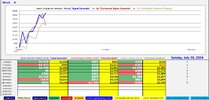- Joined
- 28 December 2013
- Posts
- 6,392
- Reactions
- 24,319
From a System Trader’s Perspective
In my opinion, there is no right or wrong method when it comes to trading. What works for one person might not work for another. It’s up to each individual to decide which method resonates with them.
Reading Chart Patterns & Researching Fundamentals
I agree that interpreting chart patterns and researching a company’s fundamentals can be subjective and vary from trader to trader. Getting a consensus is nearly impossible.
Fundamental Analysis
Personally, I find fundamental analysis to be time-consuming and not particularly enjoyable. It’s essentially a background check on a company’s past performance, assuming the information is accurate.
Chart Patterns
While patterns can look promising in hindsight, predicting future movements based on them can be challenging. We often become experts at identifying patterns after the fact, which is a major failing of most system traders.
Coding
I relate more to coding as a method of trading. It gives me the confidence to place trades through a mechanical trading system. For me, coding a trading idea stands head and shoulders above other tools in my trading toolbox.
Skate.
In my opinion, there is no right or wrong method when it comes to trading. What works for one person might not work for another. It’s up to each individual to decide which method resonates with them.
Reading Chart Patterns & Researching Fundamentals
I agree that interpreting chart patterns and researching a company’s fundamentals can be subjective and vary from trader to trader. Getting a consensus is nearly impossible.
Fundamental Analysis
Personally, I find fundamental analysis to be time-consuming and not particularly enjoyable. It’s essentially a background check on a company’s past performance, assuming the information is accurate.
Chart Patterns
While patterns can look promising in hindsight, predicting future movements based on them can be challenging. We often become experts at identifying patterns after the fact, which is a major failing of most system traders.
Coding
I relate more to coding as a method of trading. It gives me the confidence to place trades through a mechanical trading system. For me, coding a trading idea stands head and shoulders above other tools in my trading toolbox.
Skate.












